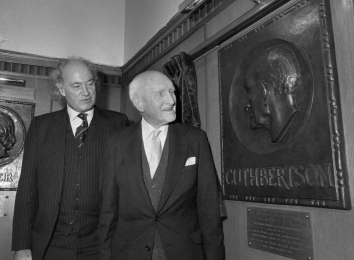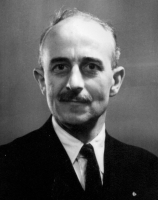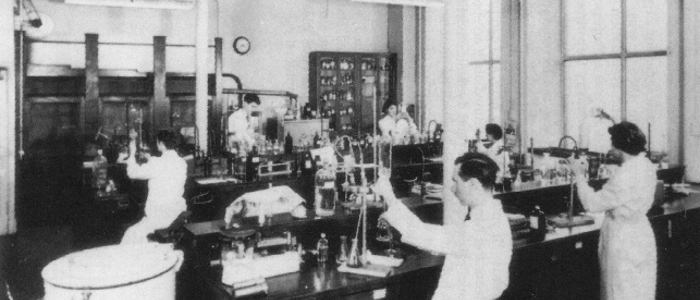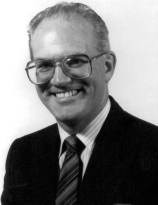Pathological Biochemistry
This summary has been prepared from Mr Simpson’s detailed history of Clinical Biochemistry in Scotland.
Royal Infirmary
University Departments of Physiological Chemistry, Biochemistry, and Pathological Biochemistry

Sir David P Cuthbertson (1900-1989) was appointed in 1926 at the age of 26 as University Lecturer and Clinical Biochemist, and was the Grieve Lecturer in Pathological Biochemistry at Glasgow Royal Infirmary from 1934 to 1945. In the world’s first metabolic ward, he studied the metabolic response to injury, and showed the importance of nutritional support. He left to be Director of the Rowett Research Institute, Aberdeen; returning to Glasgow in 1965. The European Society of Parenteral and Enteral Nutrition founded a "Sir David Cuthbertson Lectureship" in 1979 and elected Sir David as an honorary member in 1981.
He was elected an honorary member of the Association of Clinical Biochemists in 1986. Following his second retirement in 1986, a plaque was unveiled at the Royal Infirmary to commemorate his work, alongside those of Dr MacIntyre, who set up the first Radiology Department in Britain, Lord Lister and Sir William MacEwan. He wrote over 400 publications, 59 during his "retirement".
In 1947 George Wishart, who had been appointed as Senior Lecturer in Physiological Chemistry in 1934 and Gardiner Professor of Physiological Chemistry in 1935, considered that "Physiological Biochemistry" should be a discipline in its own right and proposed that he should make way for a suitable biochemist.
J Norman Davidson (1911-1972) succeeded Wishart in the Chair of Physiological Chemistry. Davidson had graduated in Edinburgh in both Chemistry and Medicine. He had his department renamed Biochemistry in 1958 and separated it from Physiology. His daughter Rona became Professor of Dermatology in the University. The department expanded from being one of the smallest in the University until, by the mid-1960s, it was one of the largest.
Davidson's personal interest was the biochemistry of nucleic acids, on which he wrote a book running to nine editions. In his department, Hamish Munro, who later moved to the Massachusetts Institute of Technology, demonstrated the first in-vitro synthesis of a protein using poly-U and transfer-RNA. Adam Fleck (PhD student) and James Shepherd (undergraduate in Biochemistry – see below) contributed to this body of work. Fleck went on to become Professor of Chemical Pathology at the University of London.

James C Eaton, from the Victoria Infirmary, Glasgow, was appointed as Consultant from 1947 to 1966. He performed important studies in the metabolic ward (Ward 44) on sulphaemoglobin, renal failure, calcium metabolism and the effect of surgical trauma on nitrogen metabolism. When the laboratory caught fire in 1951, it moved to a row of converted shops in Castle Street. The metabolic ward closed about 1960 and was replaced by a new unit in the Outpatient Department.
The metabolic studies performed included metabolic bone disease and disorders of potassium metabolism and of intestinal absorption. Dr Robert Logan supervised the four-bedded metabolic investigation unit until 1965 when he took up an appointment as Consultant Biochemist at Dumfries Royal Infirmary. He was appointed as Senior Lecturer and Honorary Consultant Biochemist in charge of the department at the Glasgow Hospital for Sick Children in 1967.
H Gemmell Morgan (1922-2006) was appointed to the newly established Chair of Pathological Biochemistry (1965-1988). He was initially based at the Royal Hospital for Sick Children, moving to the Royal Infirmary in 1966. His research interests included calcium metabolism. Morgan's aspirations were to "build up resources to establish an undergraduate teaching course, to establish postgraduate recruitment and training and to create an ambiance in which curiosity (research) would flourish and be encouraged, in particular with clinical applications".
He moved his department (renamed the Institute of Clinical Biochemistry) to the first building to be completed in the redevelopment of the Royal Infirmary, opened in 1983. The greatly expanded department housed many activities supported by research grants totalling millions of pounds. It became a major training centre. During 22 years the department produced 24 medical Consultant Biochemists, including five full professors, eight Top Grade Biochemists and many Principal Biochemists. The library contained over 1300 papers and around 45 theses which had been written by members of the department.
John (Ian) King was appointed as Principal Biochemist in 1969. Subsequently he was appointed as Top Grade Biochemist and Honorary Clinical Lecturer. Prior to his appointment in Glasgow, he wrote "Practical Clinical Enzymology" which was published in 1965. His fundamental work on the human cholinesterases gained him a PhD in 1974. He remained at the Royal Infirmary until his death in May 1978. In 1980, the Scottish Region of the Association of Clinical Biochemists established the "John King Award" in his memory.

James Shepherd was appointed as Senior Registrar in 1973. In 1976 he, and Christopher Packard, went to work under Professor A M Gotto Jr in Houston, Texas. They returned in 1977 to build up the Lipid Section of the department. Shepherd was appointed as Senior Lecturer and Consultant in 1977, Reader in 1984, Professor in 1987 and Head of Department in 1988. During the 1990s, Shepherd and Packard, with Professors Stuart Cobbe and Peter Macfarlane in , directed the West of Scotland Coronary Prevention Study (WOSCOPS), which showed the benefit of pravastatin in prevention of coronary heart disease.
They subsequently directed the PROSPER study of pravastatin in older people, which showed the benefit of pravastatin in stroke as well as . Shepherd was appointed to the executive committees of a number of other major clinical trials of statins, including Treating To New Targets (TNT) which investigated the benefits of intensive lipid lowering with atorvastatin, and JUPITER, a study using rosuvastatin to reverse vascular events in individuals with elevated C-reactive protein. He received the Association of Clinical Biochemists Foundation Award in 1998 and retired in 2006. The chair was suspended thereafter.
Chris Packard was appointed Top Grade Biochemist in 1989, Honorary Professor of Vascular Biochemistry in 1995 and Honorary Fellow of the Royal College of Physicians and Surgeons (Glasgow). He was elected FRSE and in 2014 was awarded a CBE for services to medicine. His research interests in lipid metabolism were recognised internationally (USA Berman-Zech Prize in Kinetics, and appointment as a Distinguished Fellow of the International Atherosclerosis Society in 2006). He moved to the Western Infirmary as director of the Research and Development Department first for North Glasgow, and then in 2008 for Greater Glasgow Health Board. He represented the NHS R&D function on the Scottish Government Life Sciences Advisory Board and was given an award of special recognition by Scottish Enterprise for this and his role as founding chair of Nexxus, a national bioscience network.
Naveed Sattar was appointed Professor of Metabolic Medicine in 2005; and Muriel Caslake was appointed Professor of Vascular Biochemistry in 2008 (see Cardiovascular Disease).
Trace elements biochemistry
In 1984, Professor John Lenihan retired from the Department of Clinical Physics and Bioengineering and it was decided that staff in the department's Environmental Health Unit should unite with Gordon Fell (Professor of Pathological Biochemistry 1995-) and David Halls, centralising Trace Element Services in the Biochemistry Department. The Environmental Health Laboratory had been established in 1973, formalising and reinforcing the long-standing collaboration between the University Department of Forensic Medicine and the Department of Clinical Physics and Bio-engineering.
These departments had conducted neutron activation studies of hundreds of hair samples dating back to the first century and showed that, contrary to popular belief, there is less pollution now than in the past.
Among the hair samples were specimens from:
- Robert Burns whose hair contained mercury at 8 parts per million (ppm) (compared to a typical value found today of around 2 or 3 ppm, attributable partly to dental amalgam fillings)
- Napoleon Bonaparte (whose hair had high arsenic levels)
- King Charles II (whose hair contained 55 ppm of mercury)
Endocrine biochemistry
There was great interest in endocrinology at the Royal Infirmary throughout the time that the biochemistry service was being developed. Professor Edward McGirr was eminent for his work on the biochemistry of the thyroid gland (see – Royal Infirmary).
In 1954, James K Grant, who was working in Edinburgh under Professor Marrian, was introduced to Thomas Symington, Professor of Pathology, and Alistair Currie, Senior Lecturer in Pathology. Symington had a considerable reputation for work on the adrenal cortex and Currie was interested in the pituitary gland. For a period, Grant spent one or two days a week in the Pathology Department in Glasgow, while continuing to work in Edinburgh.
In 1962 Symington, McGirr and Eric Oastler suggested to the Regional Hospital Board that a West of Scotland Regional Steroid Laboratory Service be established under Grant's direction to provide a service for the measurement of steroids in body fluids of patients. The new Steroid Laboratory was, for 20 years, one of five specialist laboratories in the UK which created Clinical Steroid Biochemistry.
John G Ratcliffe, who had been a Senior Registrar with Professor John Landon at St Bartholomew's Hospital in London, was appointed as Consultant responsible for the RadioImmuno Assay (RIA) Unit in 1972. He set up the Scottish Antibody Production Unit (SAPU) at Law Hospital, Lanarkshire, in 1974.
In 1982, following the retiral of JK Grant and the appointment of JG Ratcliffe to Manchester University, the opportunity was taken to merge the Steroid Laboratory with the RIA Unit to form the largest Endocrinology Unit of its type in the UK. Graham Beastall was appointed as Top Grade Biochemist (Endocrinology) in charge of the Unit. He was awarded CBE, Honorary Professor Richard Chapman succeeded Beastall as Principal Biochemist ().
Yorkhill Hospital
- Read more in Child Health
Robert W Logan was appointed as Senior Lecturer and Honorary Consultant at Yorkhill Hospital in 1967. Around this time, the department moved into new purpose-built premises. Logan developed the first automated system for urinary oestriol measurement in Scotland and published the first account of the use of oestrogen / creatinine ratios from random urine samples in monitoring and prediction of ovulation. These methods were later superseded by ultrasonic scanning techniques for monitoring pregnancy and major developments in monitoring ovulation induction. Assays for the investigation of inherited metabolic diseases were being developed and the department had an automated quantitative amino acid analyser, urinary glycosaminoglycan quantification and identification and had developed a range of cellular enzyme assays to diagnose lysosomal (and other) disorders.
In the 1980s, Gas Chromatography-Mass Spectroscopy (GC-MC) was developed for urinary organic acid analysis. By the mid-1990s it was clear that further sophisticated instrumentation was necessary to keep up with progress in inherited metabolic disease and eventually (mid 2001) a tandem mass spectrophotometer (the first in an NHS laboratory in Scotland) was obtained from charitable funds of the Yorkhill Children's Foundation.
Professor Forrester Cockburn had a special interest in fetal and neonatal nutrition and medicine. He developed his biochemical interests in collaboration with the Biochemistry Department and studies were undertaken to determine the effect on infant growth on the amount of copper and zinc in various milk formulae; and papers were published detailing the results and the occurrence of copper deficiency in preterm infants of very low birth weight. Through collaboration between the neonatal physicians and surgeons in the Yorkhill Hospitals and Professor Gordon Fell, Glasgow Royal Infirmary, a series of studies of trace mineral and vitamin requirements of new-born infants and children receiving parenteral nutrition were conducted. Cockburn also stimulated collaboration between Dr Matthew Dunnigan, Stobhill General Hospital, and Professor James Shepherd, Royal Infirmary, into a possible relationship between ultraviolet light, vitamin D and ischaemic heart disease.
Victoria Infirmary
Ian A Anderson, appointed Consultant in 1948, was a physician with an interest in clinical biochemistry. His special interests were endocrinology and metabolic bone disease. The Second World War, especially the campaigns in the desert and the jungles of the far East, had demonstrated the importance of salt and water balance for survival. This knowledge, together with the experience with fluid replacement in the treatment of shock on the battle field, was applied to the use of intravenous fluids for the pre and post-operative management of hospital surgical patients.
In 1968 the department became the centre, first for the West of Scotland and later for the whole of Scotland, of a quality assessment scheme. The techniques of the use of bovine plasma as a quality control were developed at the Victoria Infirmary and later, with the help of John Watt of the Protein Fractionation Unit in Liberton, Edinburgh, a system for bulk production was established.
Western Infirmary and Gartnavel General Hospital
In 1925 Stephen Veitch Telfer was appointed to a Lectureship in Pathological Biochemistry at Glasgow University. This was combined with an appointment as Clinical Biochemist to the Western Infirmary. His was the first such appointment arising from an anonymous donation to Glasgow University to provide at one or more "lectureships designed for the advancement of medical knowledge by means of biochemical or other special methods of scientific research for the Glasgow clinical hospitals connected with the University". During the 1920s he was a senior member of a team directed by Leonard Findlay, Professor of Paediatrics, which studied the problem of rickets in children.
Edward B Hendry took up this post in 1951. His initial impression of his new department was of "one large room cunningly constructed to give minimum bench space for maximum gloom space". The equipment was poor and many of the reagents were stored in paper bags. At that time, there was a research laboratory in the Gardner Institute, attached to the medical professorial unit which did all the routine work for the professorial wards. Even after Hendry’s department had been equipped, the Gardner Institute appeared to be always ahead and had several channels of Technicon Analyser before Hendry’s Laboratory.
one large room cunningly constructed to give minimum bench space for maximum gloom space
The Institute was also early in using plate chromatography and radio-isotopes. There were also large Surgical Department Laboratories and research was being conducted “in all sorts of crannies and nooks”. In 1955 additional accommodation was built between the laboratory and the surgery department.
The Western Infirmary acquired one of the first haemodialysis systems in Scotland and this was sited in the side room in Dr McCluskie's Medical Unit (see Renal Medicine). Patients were started on dialysis at 7 to 8 pm, depending on when the medical staff had finished their clinics and the surgical staff could come to install the cannulae. As there was little in the literature concerning the speed of removal of nitrogenous material, the staff assayed urea, electrolytes, creatinine and urate every hour until the early hours of the morning. In addition, the ingredients for the dialysis bath (sodium, potassium and calcium chloride, etc) were kept in weighed quantities (having been weighed by the medical staff) in the laboratory, dissolved in 5 litre flasks, checked by flame photometry and carried up the stairs to the medical unit.
Adam Fleck (1932-2015), from Glasgow Royal Infirmary, was appointed as Senior Lecturer and Honorary Consultant in 1974. He was appointed to the Chair of Chemical Pathology at Charing Cross and Westminster Medical School, London, in 1979. He was awarded the Association of Clinical Biochemists Vickers Award in 1982.
Robert W Logan, Senior Lecturer and Honorary Consultant at the Glasgow Royal Hospital for Sick Children, had his remit extended to include administrative charge of the Department at the Western Infirmary/Gartnavel General Hospital from 1980 to 1984. During this time the biochemical services throughout the Western District of Glasgow were rationalised.
Ian Percy-Robb (1935 – 2014), from Edinburgh Royal Infirmary, was appointed as Professor (personal chair) and Head of Department in 1984. In the late 1990s, he established the New Curriculum for the Medical School. He retired in 2000.
Mr Elliott Simpson
Images provided by Mr Simpson


